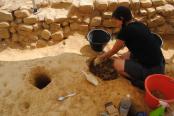CAMPAGNA 2018 |
1° SETTIMANA |
2° SETTIMANA |
3° SETTIMANA |
4° SETTIMANA |
5° SETTIMANA |
6° SETTIMANA |
7° SETTIMANA |
8° SETTIMANA |
9° SETTIMANA |
10 LUGLIO 2018 
Resoconto della giornata di scavo
Area 3000
Nella porzione settentrionale del Settore B si è proceduto con la documentazione e successiva rimozione dei resti scheletrici degli individui USK 3931 e USK 3904, orientati W-E e deposti supini rispettivamente all’interno delle fosse sepolcrali US – 3920 e US – 3908. Nella porzione sud-occidentale del settore prosegue la messa in luce dell’inumato USK 3905, orientato W-E e sepolto in posizione scomposta all’interno di una tomba piuttosto stretta. Continua inoltre lo scavo e l’indagine delle buche circolari che costituiscono la paleosuperficie US 3947, tutte piuttosto profonde e riempite da un sedimento a matrice argillosa di colore giallo-rossastro e di consistenza abbastanza compatta, con tracce di carbone. Le buche in questione hanno dimensioni diverse: UUSS – 3928, - 3937 e – 3939 hanno un diametro di 7-8 cm; UUSS – 3922, - 3924 e - 3926 misurano 28-30 cm, mentre US – 3941, che costituisce la buca angolare compresa fra US – 3924 e US – 3922, ha dimensioni notevoli, con un diametro di 43 cm, a sottolineare l’importanza del palo che probabilmente doveva ospitare.
We removed skeleton 3904 and took measurements and photos. Context sheets were filled out for the skeleton, the cut, and the fill. The skeleton in the southern half of section B was further excavated. Context sheets were filled out for the previously excavated holes. Three more holes were excavated in the southern portion. New circular cuts were identified in the northeast corner of section B.
Area 5000
At the start of today’s excavation, students began by cleaning section C for photographs. Photographs of the holes dug yesterday were taken to be used in creating 3D photogrammetry models of the site, this involved taking multiple pictures from various angles and photos, but with reference to white “points” placed around the site. Afterwards photographs of the entire context were taken. After the photographs were taken, the entire area of section C was taken down about 5 cm. The students in section D took down the area 5 cm, during which animal bones, human teeth, long bones, and bone fragments were uncovered. Marble, pottery shards, iron nails, other oxidized metals, and glass were also found. A large piece of slate was exposed adjacent to the long bone, which may indicate a cut that runs north-south.
Area 6000
Today we continued the excavation of skeleton 6222. We began by removing the large bone in the upper fill of the burial, which was previously thought to be a human pelvis and is now believed to be part of a cow pelvis due to its density and size, and was just part of the fill. We then proceeded to level the upper part of the burial to find the cranium, and further exposed the skeleton’s upper limbs to discover a left scapula. The prominent muscle insertions and tuberosity’s of the arm bones, the tibiae and the large size of the elbow joint and femoral head indicate that the individual is likely a male, but until we unearth the skeleton’s hand bones which are currently covering the os coxae, and can carefully remove the cranium for scoring, we cannot be sure. We know that this individual was very strong and robust. Moreover, a large slate was found near the head with a hollow space underneath (perhaps where the cranium has collapsed) and may have been used to cover the individual’s head. The possible presence of a head covering supports our hypothesis that the individual was buried in a wood coffin or on the surface of a wooden board. This explanation would account for the skeleton’s strange angle and the clear linear delimitation demonstrated by the foot bones, as the body would have shifted as the wood decomposed. The right scapula was also found today, also positioned higher with the rest of the right upper extremities.
In section 6229 we leveled the areas surrounding two cuts and empty clay. This exposed a fill section of stones and one cranium which was removed successfully. In the section 6228 the fill was taken out in order to expose the layer underneath the rock. The reason this was done is to see if there were any addition remains which relates to the skull in this section. Bones of the feet, hands, and long bones were exposed during this process.












